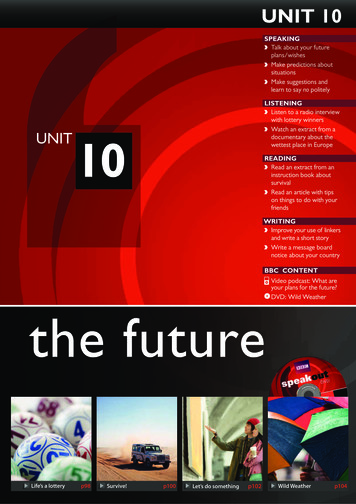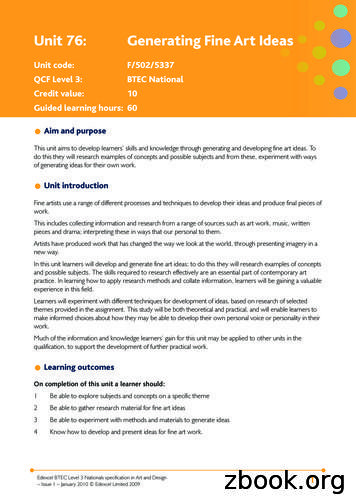Activity Ideas To Get Students Talking
Adaptable Teaching ToolsActivity Ideas to Get Students TalkingAdd interest, energy, and fun to your lessons by using a variety of activities and games that help yourstudents practice what they learn in class. Brain research shows that having fun is necessary for authenticlearning and long-term memory because it increases dopamine, endorphins, and oxygen in the brain.Review the following activities and adapt them to a variety of themes and lesson plans to reinforce learning.Line-upGoal: Students line up in sequential order.Suggested topics: Alphabetical order of first or last names, birthdate order (using month and day only),date of arrival in the United States1.Explain the topic to be practiced.2.Model the questions that students will need to ask and make sure students can ask and answer thequestions. (Examples: What’s your last name?, My last name is )3.Show the students the beginning and end of the line formation.4.Tell the students to form a line. Allow time for the students to talk together so they can line up in thecorrect order.5.When the line is formed, have the students take turns reporting their information to the whole class.(Example: My last name is Alvarez.)Memory Game or ConcentrationGoal: Students find the most matching cards.Suggested topics: Civics test questions and answers, commands and action pictures, famous people’s facesand names or titles, main verbs and irregular past tense forms, object pictures and written words1.Make sets of index cards of matching items.2.Have the students play in small groups with one set of cards per table. Cards should be mixed up andplaced upside down.3.Have the students take turns flipping over two cards to try to find a matching pair.4.If a student finds a pair, the student can keep it and take another turn.5.If the student does not find a pair, the next person takes a turn.6.Play until all the cards have been matched.www.uscis.gov/citizenship
MixersGoal: Students find the classmate with a matching card.Suggested topics: Civics test questions and answers, commands and action pictures, small talk questions andanswers1.Make a set of index cards of matching items.2.Distribute one card per student.3.Explain that each student needs to circulate to find the person with the matching card.4.Explain that the students must talk to one another to find the person with the matching card. Explainthat they may NOT show their cards to one another.5.Have the students get up, circulate around the room, and find the person with the corresponding card.6.When they find their partner, they should practice (or discuss) that item together.Category Folder ActivityGoal: Students sort information by category.Suggested topics: U.S. geography (states that border Canada, states that border Mexico, etc.), branches ofgovernment (executive, legislative, and judicial), federal and state powers1.Prepare file folders with divided sections labeled with the categories from the lesson. Create severalfolders so that your class can work in small groups.2.Prepare sticky notes with key phrases for each category.3.Have the students form groups of 4-5 and work together to place the sticky notes in the correctcolumn.Below is a sample category folder for the civics test items on U.S. geography. Prepare sticky notes with thefollowing place names (one per sticky note):Alaska, Arizona, Atlantic Ocean,California, Canada, Idaho, Maine,Mexico, Michigan, Minnesota,Mississippi River, Missouri River,Montana, New Hampshire,New Mexico, New York, NorthDakota, Ohio, Pacific Ocean,Pennsylvania, Texas, United States,Vermont, and Washington.2 Adaptable Teaching Tools H www.uscis.gov/citizenship
CornersGoal: Students stand in different corners of the room based on category.Suggested topics: U.S. geography (states that border Canada, states that border Mexico, etc.), branches ofgovernment (executive, legislative, and judicial), periods in U.S. history (1700s, 1800s, 1900s, and 2000s),famous Americans1.Similar to the Category Folder Activity, prepare sticky notes with key phrases for each category of thechosen topic.2.Make large signs for each category title and tape them in various corners of the classroom.3.Hand out one sticky note per student.4.Have the students stand up, read their note, and go to the correct corner of the room.5.Have the students in each corner read their note out loud for the class.6.Discuss and practice the civics test questions that correspond with that category.7.Collect the notes and redistribute. Have the students go to new corners.Role-playingGoal: Students practice dialogues with questions and answers.Suggested topics: Civics test items, small talk topics, commands and actions1.Write a short dialogue on the board, leaving blanks where appropriate to fill in information.2.Practice the dialogue with the class, modeling each line for them to repeat after you.3.Have the students form pairs and decide the roles of the applicant and USCIS officer.4.Have the students practice in pairs. Once they have practiced, they can switch roles.5.Circulate and provide guidance.6.Have each pair perform the dialogue for the class.Inside-Outside CirclesGoal: Students practice a short exchange withdifferent partners.Suggested topics: Greetings, small talk topics, questions andanswers about personal identification information1.Model a target question and possible answers that studentswill ask each other. (Examples: Where are you from?, I’mfrom )2.Ask the students to stand up and form two circles (seediagram). One circle is inside the other.3 Adaptable Teaching Tools H www.uscis.gov/citizenship
3.Have the students standing in the inside circle face those in the outside circle. The students in theoutside circle should face inward.4.Explain that the outside circle students will ask the target question and the inside circle students willanswer. Explain that after they talk together, the students on the outside circle will move one person tothe right and begin the exchange again.5.Have the students start with the question and answer exchange. When you call time, the outside circlemoves one person to the right. Then the students repeat the process, asking the same question with thenew partner.6.Have the circle rotate until the students have talked with several different classmates.Speed SpellingGoal: Students practice spelling new vocabulary using alphabet letter tiles.*Suggested topics: Vocabulary from Form N-400, Application for Naturalization, vocabulary lists from thereading and writing tests, civics test vocabulary1.Have the students form groups of 4-6 players around a table with one set of alphabet letter tiles.2.Explain that you will call out a word, and that they should, as a group, find the letters and form thatword on the table.3.When the word is spelled correctly, the students should raise their hands to have their word checked.4.The first group to spell the word correctly is the winner of that round.5.Some groups may need several tries to spell the word correctly. Tell them to try again and check backlater.6.When every group has the correct spelling, ask the winning group, or one student, to spell the wordout loud.7.Ask a follow-up question using the word they just spelled to help reinforce the meaning in context.* You can use sets of alphabet letter tiles from board games for this activity or make your own sets. Printout the reproducible template of “letter tiles” (see Appendix A), preferably on hard-stock paper. Cut outthe tiles and store each set in a separate plastic bag. Distribute one bag of tiles to each group of students.Conversation GridGoal: Students ask and answer questions about themselves and practice requests forclarification.Suggested topics: Birthdates and birthplaces, marital status and children, address informationPreparation tip: Review clarification phrases, such as “Please repeat that” and “Please spell that,” beforebeginning this activity. It is helpful to display these phrases on the board where students can easily refer tothem during the activity.4 Adaptable Teaching Tools H www.uscis.gov/citizenship
1.Write the target questions on the board and practice them with the whole class. (Examples: What isyour birthdate?, What is your birthplace? or When were you born?, Where were you born?) To protectyour students’ personal information, have your students report their birth month and day only for theirbirthdate.2.Have the students form pairs so they can practice asking and answering the questions with each other.3.Distribute the handout Conversation Grid (see Appendix B), one per student.4.Explain the labels of the three columns: Name, Birthdate, and Birthplace. Explain that the students willeach interview five classmates and write the answers in the appropriate column. Explain that, for thisactivity, they should report their month and day only for their birthdate.5.Direct the students to get up and interview five other students.6.Encourage the students to use clarification phrases with each other.7.Circulate and provide guidance as needed.Adaptation: Using the blank Conversation Grid master (see Appendix C), create your own version to adaptto a current lesson in your curriculum. Choose two related questions from your lesson to review andwrite them on the board, such as, “What is your marital status?” and “How many children do you have?”Distribute copies of the blank grid and have the students label each column respectively with “MaritalStatus” and “Children.” Then follow the steps described above.5 Adaptable Teaching Tools H www.uscis.gov/citizenship
Appendix A Speed SpellingA A AB B BD E EE E FH H HI J JL L MN N NO O OR R RS S ST U UWWWACEFHJMNPRSUXACEFIKMOPRTUX6 Adaptable Teaching Tools H YADEGILNOQSTVYADEGILNOQSTVZBDEGILNORSTWZ
Appendix B Conversation Grid (Birthdate and Birthplace)NameBirthdate (month and day)1.2.3.4.5.7 Adaptable Teaching Tools H www.uscis.gov/citizenshipBirthplace
Appendix C Conversation Grid (Blank Master)Name1.2.3.4.5.8 Adaptable Teaching Tools H www.uscis.gov/citizenship
1. Make sets of index cards of matching items. 2. Have the students play in small groups with one set of cards per table. Cards should be mixed up and placed upside down. 3. Have the students take turns flipping over two cards to try to find a matching pair. 4. If a student finds
strategy back on track. In this guide, we'll be sharing 69 marketing ideas and inspirational tips to help you bust through that brick wall, including: n PPC Marketing Ideas. n Content Marketing Ideas. n Social Media Marketing Ideas. n Urban Marketing Ideas. n Contest Marketing Ideas. Let's get started! PPC MARKETING IDEAS. Try a new keyword .
work/products (Beading, Candles, Carving, Food Products, Soap, Weaving, etc.) ⃝I understand that if my work contains Indigenous visual representation that it is a reflection of the Indigenous culture of my native region. ⃝To the best of my knowledge, my work/products fall within Craft Council standards and expectations with respect to
ÍNDICE Inglés Español PRESENTACIÓN WELCOME DESARROLLO Activity 1: English Backpack Activity 2: Time to learn Activity 3: My Schedule Activity 4: About me Activity 5: Treasure Hunt Activity 6: Staying Safe part 1 Activity 7: Staying Safe part 2 Activity 8: Staying Safe part 3 Activity 9: Staying Safe part 4
ÍNDICE Inglés Español PRESENTACIÓN WELCOME DESARROLLO Activity 1: Greetings and Farewells Activity 2: Greetings Activity 3: Stop and Go Activity 4: About Myself Activity 5: I want to be a Scientist Activity 6: Rhymes part 1 Activity 7: Rhymes part 2 Activity 8: Rhymes part 3 Activity 9: Nursery Rhymes Activ
Hula Hoop Pass x x x x x Activity #2 Human Knot x x x x x Activity #3 Clothes Pin Tag x x x x x Activity #4 Head & Shoulders, Knees & Toes x Activity #5 Get Active Jumping Rope x x x x x Activity #1 Abdominal Tag x x x Activity #2 Get in the Movement Groove x x x x x Activity #3
speakoutTIP The verb get has more than twenty meanings in English! It can mean ‘become’ (get hungry), ‘arrive’ (get home), ‘obtain’ (get a job), ‘buy’ (get a new car) and is in many phrases: get up, get on a plane, get dressed. When you hear or see the word get, think about which meaning it has. Which meaning does get have in these
fine art ideas [IE] M2 experiment purposefully with materials and methods in creating individual ideas P3 experiment with methods and materials to generate ideas [CT] M3 develop and present individual ideas effectively. P4 select and present ideas for development of fine art work. [CT, RL]
and Ideas Questions on the Reading Test can be sorted into three categories: (1) Information and Ideas, (2) Rhetoric, and (3) Synthesis. This chapter focuses on the first category, Information and Ideas. Information and Ideas: The Author's Message. Information and Ideas questions ask you to think carefully about the author's message.























